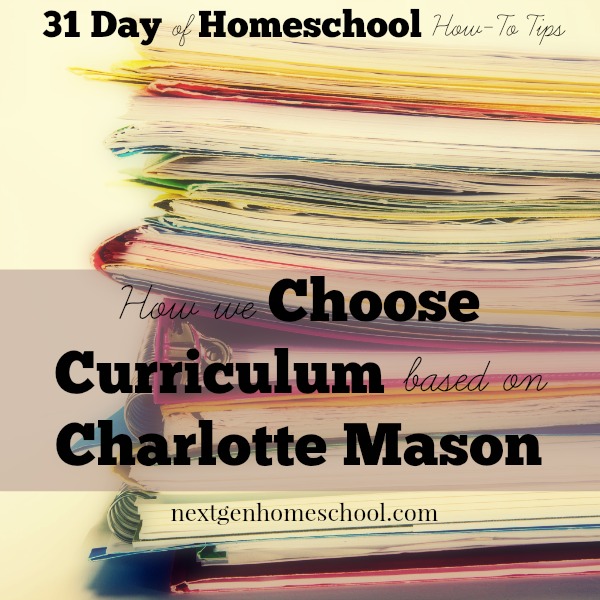Welcome to our October “31 Days” series at NextGen Homeschool: 31 Days of Homeschool How-To Tips! As NextGen Homeschoolers, we remember what it was like to be homeschooled ourselves, and our experiences as students have helped shape many of our best systems and strategies today. In the next 31 days, we’ll be sharing with you what’s working for us, answering the most common questions we get from today’s first-generation homeschooling moms.
How we Choose Curriculum based on Charlotte Mason
Choosing curriculum can be super scary for some, I’ve learned, but I have absolutely enjoyed choosing curriculum. I think this is because before I ever looked at any, I had a clear idea of the direction I wanted to take in educating my children after reading many books and blogs from recommended authors. That advance research helped me narrow down the possibilities from thousands of options — and I didn’t even go to one of those big homeschool conventions.
Choosing curriculum has so much to do with your faith (what you believe is important to impart to your children), your season of life (one kid, two kids or eight kids like my mom) and your own personality in general (whether you like to read teachers manuals to give you security or you are more creative and like to be a part of the entire learning process).
That said, I have to admit that I am starting my journey as a homeschool mom veering far from the ways I was homeschooled. I can see in retrospect that my mom’s approach as a mother of eight probably had a lot to do with survival. We used Alpha Omega packets for science and history and regular school textbook for math and English. Being an older student, I generally was doing my work independently, which wasn’t too hard to do with these basic tools.
Though I was artistic at heart, we never made a point to read any great literary works (just some biographies), observe nature in its natural setting or study any art history — which I don’t begrudge because I have found my way to these things as an adult. We covered the basics, and I was also able to stay clear of traditional school socialization pitfalls (see our previous post on homeschool socialization).
Because of my past experience, I didn’t gravitate to the homeschool books I remember seeing on the bookshelf as a kid: Instead, the first book I picked up was “For the Children’s Sake” by Susan Schaeffer Macaulay, and I am so glad I did. I found my eyes opened to an even more exciting reason to educate my children at home rather than the usual “fear of the government” and “bad kids” motivators. I saw an opportunity to open doors for my children to a true love for learning and beauty in all aspects of life through the educational philosophies of Charlotte Mason.
This was a totally different way of seeing education that I was used to. Not just reading, writing and arithmetic, though those things will always be a part of education. Charlotte Mason said “Education is a discipline, education is an atmosphere and education is a life.” This point of view is seeing your children as born people who — when nurtured on a feast of noble ideas through “living” books, picture study, nature study and all the things we usually deem as “extras” — are better able to develop their own ideas utilizing all that is at their disposal: God’s world in nature, art, literature, history, music and, of course, God’s written Word.
Some websites I enjoy and resources for living books lists:
- Simply Charlotte Mason: Free ebooks about Charlotte Mason Education.
- Ambleside Online: I don’t follow scheduling exactly, I just use the resource lists.
- Moments with Motherculture: Encouraging and inspiring author, her books are a “must” read.
Other Resources I found helpful and enriching:
- Five in a Row: I don’t do the actual reading Five in a Row, but I use the study guides when we read the books to cover a particular subject.
- Practical Pages: Pulls together Charlotte Mason and notebooking.
- Doorposts: For habit and character training.
- Explode the Code: Phonics
- Handwriting Without Tears: Introduction to handwriting.
- Montessori Letters Montessori-Small-Movable-Alphabets-Box: For spelling practice.
NEW FOR FALL: These are specific curriculum sources that I’ve chose for the upcoming year to work with my 2nd grader Elijah and preschool/kindergartener Arielle:
- Queen Homeschool: Language for Little Ones and Living Math Series. These are workbooks without being dumbed down — still following Charlotte’s methods (like including poetry, picture study and living stories). I plan to use them at different levels for both children.
- Life of Fred for both (different books)
- Science: The LBC Guide to Astronomy & Discovering Nature series: Our Animal Friends (also from Queen Homeschool)
- History: My Father’s World 2nd grade Adventures in U.S. History (including readers and read-alouds from Beautiful Feet and a living books reading list). For kindergarten: Christian Liberty Press History for Little Pilgrims (including read-alouds and living books curriculum).
- Happy Phonics & Handwriting Without Tears for Kindergarten Language Arts
It is my hope that my kids will become truly educated individuals in every sense of the word, to be able to discourse with every type of person, to see every day as an opportunity to enjoy what God has created, to see beauty in words and art and life, and to put God first above all else in all of life’s circumstances.
How did you decide what curriculum you would use for your homeschool, and has it changed over the years? Did any prior experience with homeschooling have an impact on your decisions? What’s new in your curriculum plan for this current school year?





